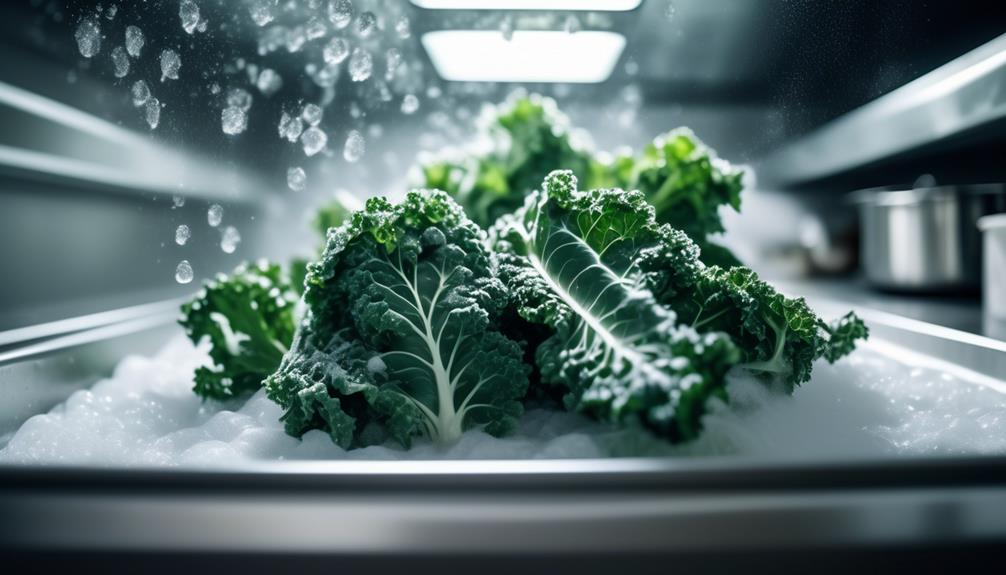When life gives you kale, don't let it wither away; freeze it instead.
You'll need to start by selecting the freshest leaves you can find—vibrant, deeply colored, and free from blemishes.
Wash them thoroughly to remove any hidden dirt or critters, then pat them dry with a clean towel or spin them in a salad spinner.
The key to maintaining that bright green color and hearty texture lies in blanching your kale for a couple of minutes in boiling water—just long enough to halt the enzymes that lead to spoilage.
After blanching, you must plunge the leaves into an ice bath to stop the cooking process immediately. This step is crucial.
If you're wondering just how to do it right, along with the subsequent steps of drying, portioning, and packaging your kale for optimal freshness, you'll want to follow along closely as we unravel the nuances of preserving this nutrient-packed green for future use.
Key Takeaways
- Choose fresh, vibrant leaves for freezing
- Blanch kale leaves to preserve color and nutrients
- Cool and dry blanched kale before freezing
- Portion and package kale properly for optimal freshness
Selecting and Preparing Kale
Before you freeze kale, choose fresh, vibrant leaves and wash them thoroughly to remove any dirt or debris. You'll want to start by selecting the best kale varieties for freezing. Look for leaves that are dark green and firm, avoiding any that are yellowed or wilted, as these won't hold up well in the freezer. Curly kale and Tuscan kale, also known as lacinato or dinosaur kale, are excellent choices due to their texture and flavor retention after freezing.
When it comes to washing techniques, don't skimp on this step. Place the kale in a large bowl of cold water, swishing it around to loosen any lingering dirt. You may need to change the water a couple of times until it runs clear. For an extra clean, you can also use a vegetable brush on the leaves. Shake off the excess water or use a salad spinner to get the leaves as dry as possible. Excess water can cause ice crystals to form, which can degrade the quality of your kale when thawed.
Once your kale is clean and dry, you're well on your way to preserving this nutritious green for future use.
Blanching Kale Leaves
Having selected and prepared your kale, the next step is to blanch the leaves, which will preserve their vibrant color and nutrients before freezing. Blanching is a quick process of scalding vegetables in boiling water, then plunging them into ice water to halt the cooking. This step is crucial for most kale varieties, whether you're freezing curly kale or lacinato.
Here's how to blanch your kale:
- Bring a large pot of water to a rolling boil.
- In the meantime, prepare a bowl of ice water large enough to submerge your kale leaves.
- Place the kale leaves in the boiling water for about 2 to 3 minutes.
- Quickly transfer the blanched leaves to the ice water to stop the cooking process.
- Drain the kale thoroughly after it has cooled down.
If you're looking for blanching alternatives, steam blanching is an option that uses less water and can help retain some of the kale's water-soluble nutrients. Simply use a steamer basket over boiling water, cover, and steam the kale leaves for the same amount of time you'd blanch them. After steaming, plunge the leaves into ice water as you'd after traditional blanching.
Cooling and Drying Kale
After blanching, immediately cool your kale leaves in the ice water to prevent further cooking and ensure they retain their crisp texture. This quick cooling process is vital for maintaining the vibrant color and nutritional value of the kale, making it perfect for future salad inclusions or for making kale crisps.
Once your kale leaves are thoroughly chilled, drain them well. It's crucial to remove as much water as possible to avoid ice crystal formation, which can damage the leaf structure. Pat the leaves dry with a clean kitchen towel or let them rest on a dry surface for a few minutes.
Here's a quick reference table for the cooling and drying process:
| Step | Description | Tips |
|---|---|---|
| Cooling | Plunge kale into ice water | Use plenty of ice |
| Draining | Remove from water and let excess drip off | Tilt colander to aid drainage |
| Drying | Pat leaves dry with a towel | Change towels if saturated |
| Storage Prep | Prepare leaves for freezing | Lay flat to prevent clumping |
Once your kale is dry, you're ready to pack it for freezing. Lay the leaves flat on a baking sheet if you want to pre-freeze them before bagging, which can help prevent the leaves from sticking together. This way, you'll have individual pieces ready for your next smoothie or kale crisps snack.
Portioning and Packaging
Ensure you portion your kale into the desired amounts for each use before sealing them in airtight packaging to maintain freshness and ease in future meal preparations. When you're freezing kale for smoothies or dinners, it's crucial to consider how much you'll need for a single serving or recipe.
Here's how to do it right:
- Measure Out Servings: If you're planning on using kale for smoothies, create kale smoothie packs by measuring out the amount of kale you typically use per smoothie.
- Flat Packing: Lay the kale flat in a freezer bag to remove as much air as possible; this helps prevent freezer burn and saves space.
- Vacuum Sealing: For optimal freshness, use a vacuum sealer. Vacuum sealing removes all the air and seals the kale in a tight package, dramatically extending its shelf life.
- Labeling: Write the date and contents on each package. This helps you keep track of freshness and organize your freezer inventory.
- Avoid Overstuffing: Don't pack too much kale into one bag. Overstuffing can lead to uneven freezing and make it harder to break apart portions when you're ready to use them.
Storing and Thawing Tips
When you store your frozen kale, place it in the back of the freezer where the temperature is most consistent to prevent thawing during the appliance's defrost cycle. This practice is crucial to maintain the kale's nutrition, as improper storage can lead to nutrient degradation. Ensure that your freezer organization allows for good air circulation, which helps keep the kale frozen solid.
For optimal longevity, label your kale with the freezing date and aim to use it within 8-12 months. This timeframe helps preserve not just the kale nutrition but also its flavor and texture.
When it's time to thaw your kale, plan ahead. Transfer the needed amount from the freezer to the refrigerator and let it thaw slowly, usually overnight. This gentle process helps retain the nutritional value and prevents the leaves from becoming soggy. If you're in a hurry, you can also thaw kale under cold running water or in the microwave using the defrost setting. Just be sure to use it immediately after thawing to ensure the best quality and to reap the maximum kale nutrition benefits.

